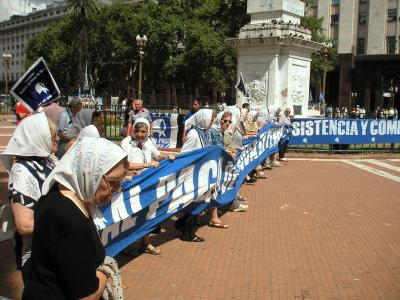
Translation mine. Linkage added.The comments at the site are full of anger, as well they might be. Alfredo Astiz is one of the most infamous of the ESMA’s many foul repressors. Along with the murders of the French nuns, who had worked with the poor in the farming province of Corrientes, he is also known to have infiltrated the Mothers of Plaza de Mayo, pretending he had lost a brother to the dictatorship. It was a lie, of course. As was Astiz’s later claim that he was “just following orders”. One of the leading Mothers wound up being “disappeared” herself; that was Astiz’s doing. Up to now, Astiz has gone largely unpunished. What justice has found him, has been at the hands of ordinary citizens taking revenge the only way they could. According to Marguerite Feitlowitz’s A Lexicon of Terror,The repressor Alfredo Astiz was admitted to the Naval hospital in Buenos Aires, 24 hours before the beginning of the trial for the Task Force which operated in the Navy Mechanics’ School (ESMA) during the last military dictatorship.Astiz was transferred from the Marcos Paz penitentiary, where he was in preventive custody, due to an apparent complication of a kidney tumor.The hospitalization of Astiz makes it unlikely that he will be present for the opening of the trial which Oral Tribunal No. 5 (TOF 5) will begin on Friday for 19 repressors, for crimes against humanity committed at the ESMA.Among the 19 who will be tried, along with Astiz, are Jorge “El Tigre” Acosta, Antonio Pernías, Jorge Rádice, Juan Carlos Rolón, Carlos Capdevilla, and Ricardo Miguel Cavallo.Among the crimes for which they will be tried are the kidnapping and disappearance of the journalist Rodolfo Walsh, and the French nuns Léonie Duquet and Alice Domon.The trial against the ESMA torturers has already been suspended twice. The first time, it was postponed due to proceedings for crimes committed in the Campo de Mayo jurisdiction, in which life sentences were handed out to ex-subcommander Jorge Olivera Roverre and ex-colonel Bernardo Menéndez. Three other chiefs were acquitted. Later, the trial was again postponed because one of the tribunal judges had to be replaced.This Thursday, from noon to midnight, several human-rights organizations will be holding a Resistance March, which takes place every December 10, at the Plaza de Mayo, in memory of the 30,000 disappeared persons. The 29th march will be headed by the Grandmothers of Plaza de Mayo, Mothers of Plaza de Mayo, HIJOS, families of the disappeared and political prisoners, and Siblings. Among other things they are calling for the living reappearance of Julio López, the witness who disappeared just before the trial of the repressor, Miguel Etchecolatz.
What the father said explains a lot, does it not? This is why, in Argentina, there is still so much unresolved. The courts are often stacked with old repressors or their sympathizers; the police and military ranks likewise. Corrupt politicians are as common as dirt. With “authorities” like that, is it any wonder that ordinary citizens are reduced to hauling known repressors like Astiz out of their cars and beating the shit out of them?And is it any wonder that the HIJOS, the Mothers and Grandmothers of Plaza de Mayo, the “reappeared” ones, and so many others, hold these big annual protest marches?Until there is real change in Argentina, this seems to be the form that justice will take–a combination of angry, impulsive outbursts and dignified organized protests that make so much noise that no one could miss them.(Muchas gracias to Otto for drawing my attention to this story.)The first assault was in the ski resort of San Carlos de Bariloche. Astiz and a female companion were waiting for the bus to take them to the slopes, when the Blond Angel [Astiz] was recognized by a former detainee in the camp called Vesuvius. “All I could see were [the Mothers’] white kerchiefs,” said the assailant, Alfredo Chávez, a witness at the trial of the ex-commanders. “Son of a bitch! Killer of adolescents!” he yelled, and punched Astiz in the nose. […] Encouraged by the [navy], Astiz filed suit. For counsel he retained Pedro Bianchi, the lawyer who was defending Erich Priebke, the Nazi who, until his extradition, lived close to the Bariloche ski resort. The next attack took place in greater Buenos Aires; the assailants this time were two brothers, age nineteen and twenty, taking their dog to the vet. […] En route, a car pulled in front of them, blocking their way. From behind his window, the driver, Astiz, taunted the boys with an obscene gesture. The captain was recognized by the younger brother. Though this attack was worse, neither Astiz nor the navy reported it to the police. No one came to the captain’s defense as the brothers pulled him from his car, hit him so hard in the mouth his dental plate popped out, then bashed in the hood of his vehicle. “Good boys! Kill him!” yelled a woman through the open window of a bus. […] The boys’ father, a devoutly religious man, did not defend his sons’ behavior, but offered an explanation that struck a chord with many parents with whom I spoke: “This is what happens after you’re obliged to tell your children that justice here doesn’t function as it should, that the courts refused to castigate the most horrendous crimes of a horrendous dictatorship.”



